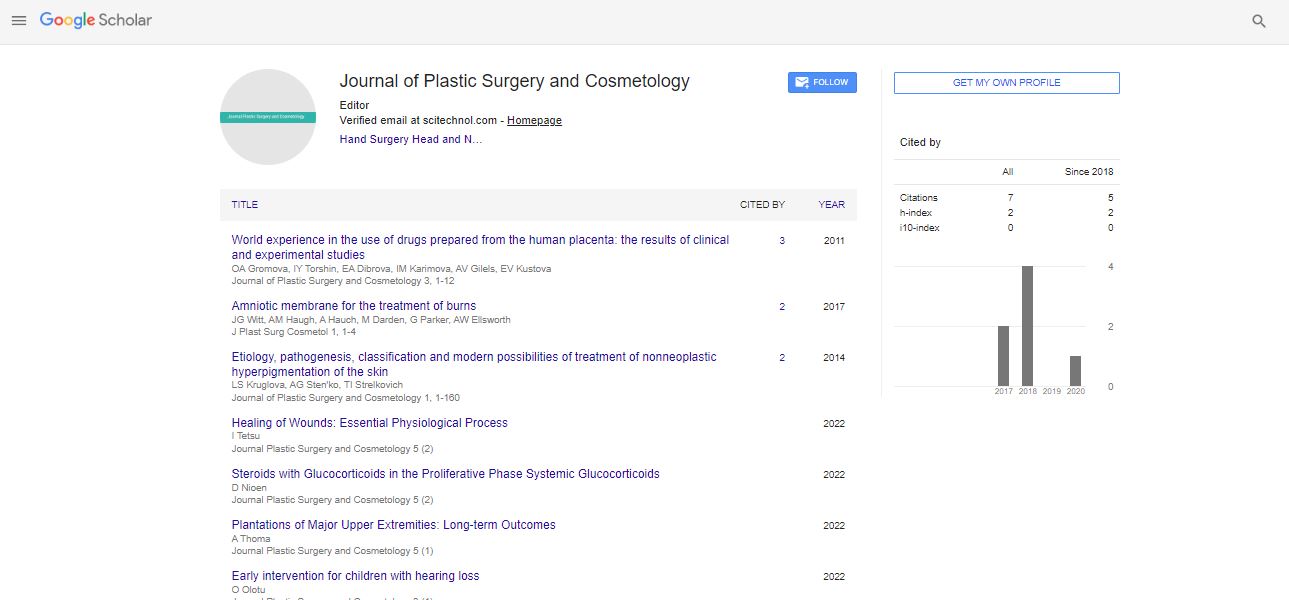Outpatient screening and prevention of complications in the correction of agerelated changes in the periorbital region with a dysplastic phenotype
Natalia Bychkova
RUDN University, Russia
: J Plast Surg Cosmetol
Abstract
Statement of the Problem: Connective tissue dysplasia (CTD) is a heterogeneous group of conditions caused by defects in the genes responsible for the synthesis of all components of the extracellular matrix and subsequent post-transcriptional modifications. Phenotypic manifestations of CTD are described in the form of clinical and functional syndromes such as «cosmetic syndrome» accompanied by specific changes in appearance and the early signs of aging manifestation. Dysplastic-dependent changes are often observed in the periorbital region and include the appearance of folds, creases, hernias and furrows. This leads to dysphoria, a decrease in the quality of life and becomes the reason for contacting cosmetologists and plastic surgeons. Methodology & Theoretical Orientation: To optimize the methods of screening CTD at an outpatient appointment was developed a questionnaire "Characteristics of the dysplastic phenotype during invasive procedures and manipulations" which allows for assessing the state of the respondent's connective tissue. Findings: Patients with DST have a low regenerative potential of skin and skin barrier dysfunction and also leads to violation of autoregulatory molecular mechanisms and signalling pathways of metabolism of the connective tissue of the dermis which changes the ability of reparative processes, increases the risk of pathological scarring and leads to a higher risk of complications. Conclusion & Significance: Timely diagnosis and mesotherapeutic correction can reduce the severity of age-related changes observed in dysplasia by regulating the metabolism of components of the connective tissue of the dermis, as well as activating mechanisms of self-regulation and restoration of signalling pathways.
References :
1. Borzykh OB, Petrova MM, Karpova EI, Shnayder NA. Connective tissue disease in the practice of a cosmetologist and dermatologist. Features of diagnosis and management of patients. Vestnik dermatologii i venerologii. 2022; 98(1):19-32
2. Chaigne B, Scirè CA, Talarico R, Alexander T, Amoura Z, Avcin T, Beretta L, Doria A, Guffroy A, Guimarães V, Hachulla É, Krieg T, Launay D, Lepri G, Moinzadeh P, Müller-Ladner U, Rednic S, Rodrigues A, Tas SW, van Vollenhoven RF, Vieira A, Bombardieri S, Fonseca JE, Galetti I, Schneider M, Smith V, Cutolo M, Mosca M, Fischer-Betz R. (2018) Mixed connective tissue disease: state of the art on clinical practice guidelines. RMD Open. 2018; 4 (suppl 1): e000783.
3. Druk IV, Nechaeva GI, Oseeva OV, PomorgaÄlo EG, Maksimov VN, Ivanoshchuk DE, Gol'tiapin VV. [Personalized Risk Assessment of Adverse Cardiovascular Events in Young Patients With Connective Tissue Dysplasia]. Kardiologiia. 2015;55(3):75-84.
4. Kildiyarova RR, Nechaeva GI, Chernyshova TE. Connective tissue dysplasia. M.: GEOTAR-Media; 2020;160.
5. Minaev SV, Grigorova AN, Vladimirova OV, Timofeev SI, Sirak AG, Vladimirov VI, Pogosyan AA, Zelenskaya MV. Vliyanie differentsiatsii soedinitel'noi tkani na formirovanie rubtsovoi tkani v detskom vozraste [Influence of connective tissue differentiation on scar tissue formation in children]. Khirurgiia (Mosk). 2021;(5):72-77.
6. Nikolenko VN, Oganesyan MV, Vovkogon AD, Cao Y, Churganova AA, Zolotareva MA, Achkasov EE, Sankova MV, Rizaeva NA, Sinelnikov MY. Morphological signs of connective tissue dysplasia as predictors of frequent post-exercise musculoskeletal disorders. BMC Musculoskelet Disord. 2020 Oct 8;21(1):660
Biography
Natalia. Byckova PhD, Associate Professor of the Department of Aesthetic Medicine at Russian Peoples' Friendship University, member of the profile commission for dermatovenereology and cosmetology of the Russian Ministry of Health, president of the Association of Aesthetic Medicine Section, chairman of the expert council for the treatment of complications in cosmetology. The research activity is devoted to topical issues of dermatology, plastic surgery and cosmetology using objective evidence-based methods. The use of the dialogue questionnaire method at the stage of anamnesis collection allows to identify signs of connective tissue dysplasia before cosmetic procedures and optimize the patient's treatment plan, which is of great importance for practical healthcare. Extensive clinical experience in interdisciplinary management of patients with connective tissue pathology allows a comprehensive approach to all emerging problems in solving issues of therapy and rehabilitation
 Spanish
Spanish  Chinese
Chinese  Russian
Russian  German
German  French
French  Japanese
Japanese  Portuguese
Portuguese  Hindi
Hindi 